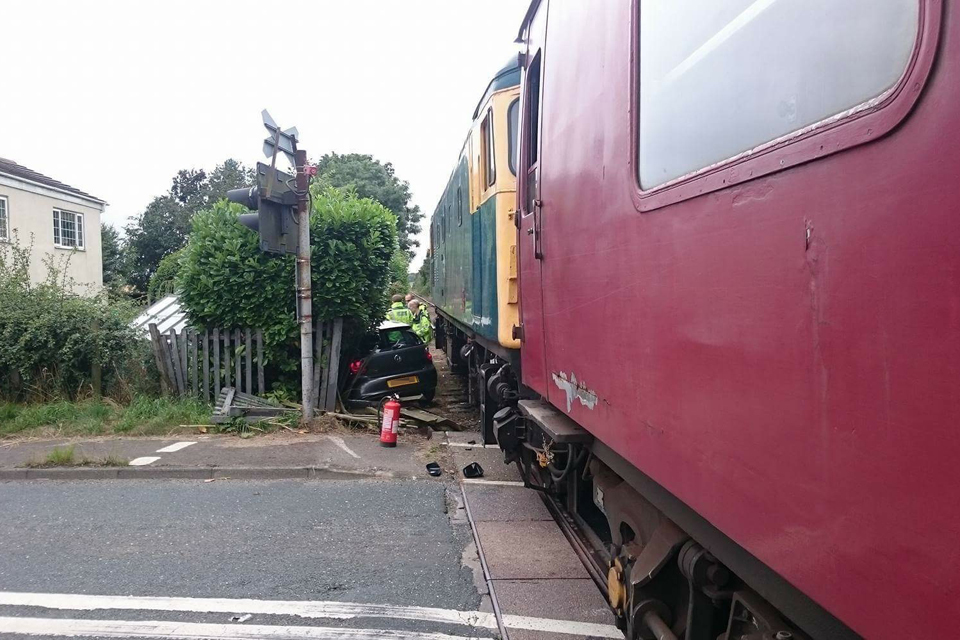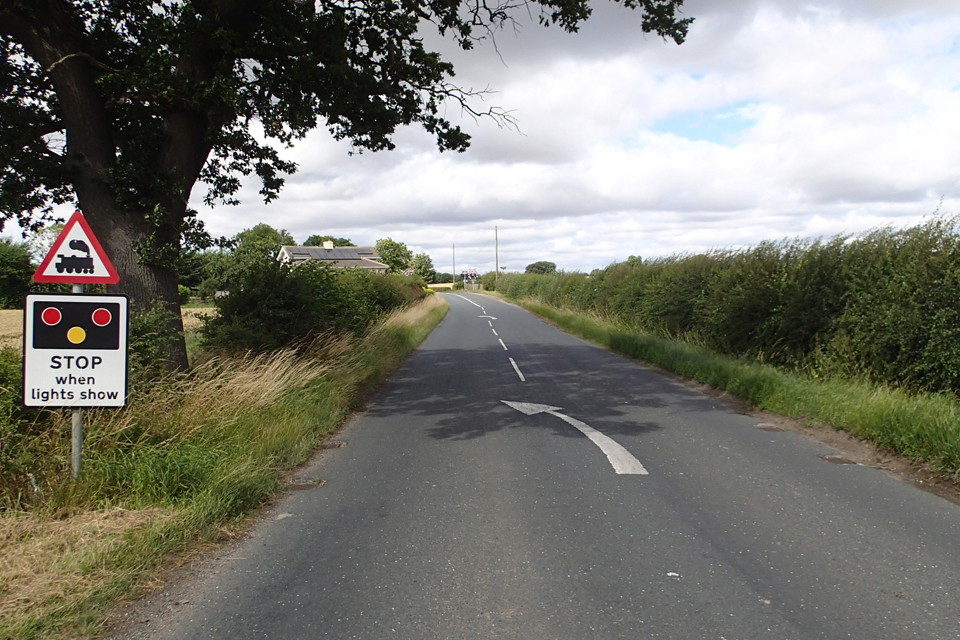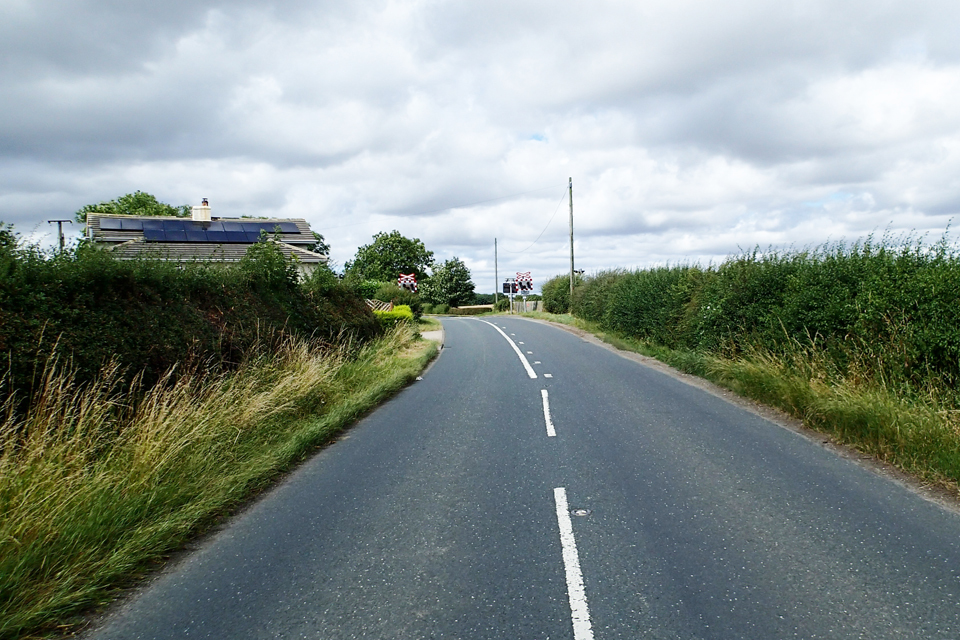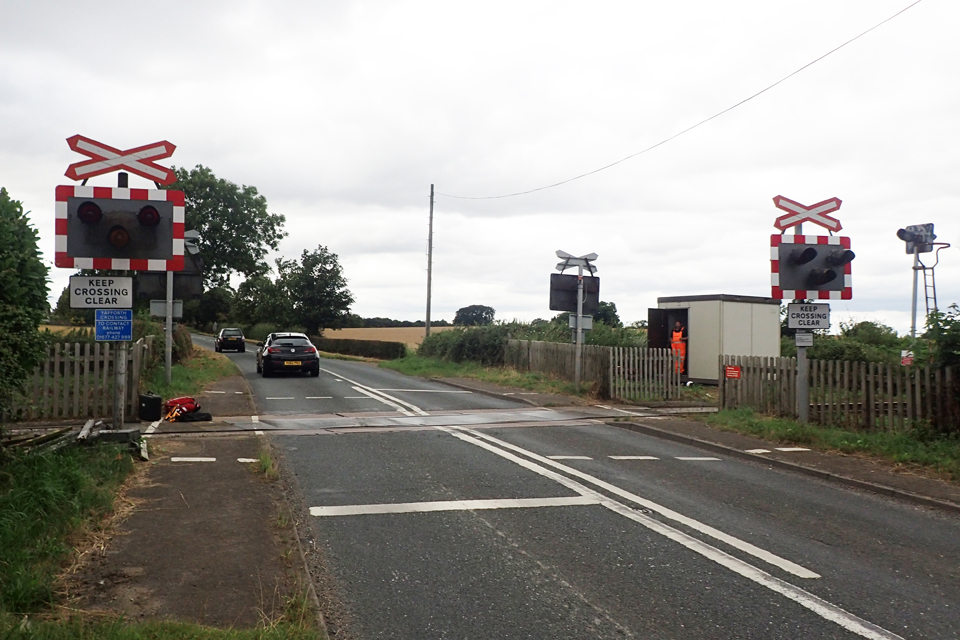Collision at Yafforth level crossing, 3 August 2016
Published 10 November 2016
1. Important safety messages
This accident illustrates the importance of:
- road traffic signals at level crossings being visible and sufficiently conspicuous to draw the attention of approaching road users
- replacing 36 Watt incandescent lamps in level crossing road traffic signals with lamps that have a higher level of brightness, such as modern LEDs
- infrastructure managers giving careful consideration to the factors which influence user behaviour at level crossings without barriers and the potential value of installing barriers at higher risk locations
- appropriate competency management arrangements for staff maintaining safety critical equipment.
2. Summary of the accident
On 3 August 2016, at around 13:55 hrs, a passenger train struck a car on Yafforth level crossing, near to Northallerton, North Yorkshire. As a result of the accident, the driver of the car was trapped in their vehicle and received injuries which required hospital treatment. The car was later reported as having been damaged beyond economic repair. Two passengers on the train also received minor injuries. Fencing at the crossing was destroyed and the train involved was slightly damaged.

A locomotive and a burgundy railway carriage stopped on the level crossing at Yafforth. Members of the emergency services are standing near a small hatchback which is in a hedge surrounded by damaged fencing. (image courtesy of the Wensleydale Railway)
3. Cause of the incident
The train involved in the accident consisted of a Class 26 diesel-electric locomotive and three passenger coaches. The train was travelling in the westbound direction when the collision occurred. The car which was involved approached Yafforth level crossing from the south.
At Yafforth level crossing, Dolly Lane crosses the section of the Wensleydale Railway which runs between Northallerton West and Leeming Bar stations. The Wensleydale Railway is a heritage railway and this section is open for scheduled passenger services between 09:00 and 18:00 hrs on three days a week for around nine months of the year. Freight and engineering trains operate in the section at other times. 3 August 2016 was the first day that scheduled passenger services had operated over the crossing since the end of 2015 because track engineering work was being undertaken at Northallerton.

The road on the approach to Yafforth level crossing from the south. Trees and hedges line each side of the road with shadows across the road. A warning sign telling road users to stop when the lights show is on the left hand side.
The railway at Yafforth level crossing consists of a single track. Trains operate over the crossing in both the westbound (down) and eastbound (up) directions. The maximum permitted speed that trains can pass over the crossing (the ‘crossing speed’) is 10 mph (16 km/h). At the time of the accident, no more than 10 trains per day were scheduled to pass over the crossing.
Dolly Lane is a single-carriageway road, subject to the national speed limit. This is 60 mph (96 km/h) for cars. The road runs approximately north to south, with the railway crossing it at a skew. The road approach to the crossing from the south has a number of changes in direction and vertical profile. This includes a left-hand bend which starts around 50 metres from the crossing.

The approach to Yafforth level crossing from the south, showing the road layout around 65 metres from the crossing. The level crossing lights can be seen. A large white house is just to the left of the crossing.
Yafforth level crossing is of the automatic open locally monitored (AOCL) type. The crossing is not protected by gates or barriers and its road traffic signals, and audible warning devices for pedestrians, are triggered automatically by approaching trains. Train drivers are required to observe the crossing as they approach it from a specified point, which is marked by a railway sign called a special speed restriction board (SSRB). On reaching the SSRB, the train must be at the required crossing speed and the train driver must be able to see that the crossing is both clear of users and that the road traffic signals are functioning. Only if these conditions are met can the train proceed over the crossing.
The status of the road traffic signals at an AOCL is shown to train drivers via a railway signal called a driver’s crossing indicator. At Yafforth level crossing, this indicator is a flashing white light which is activated once the correct function of the road traffic signals has been confirmed by the crossing’s electrical circuits.
The weather at the time of the accident consisted of sun, scattered clouds and a gentle breeze. Although a light rain shower was recorded around the time of the accident, photographs taken about 15 to 25 minutes after the accident occurred showed that the road surface was dry. Analysis of the position of the sun shows that, when the accident occurred, the sun was shining from the south-west (ie behind and to the nearside of road vehicles approaching the crossing from the south) and that it was high in the sky. The RAIB has concluded that the effect of the sun was probably not a factor in this accident.
The car driver was a local resident who was familiar with the road. They frequently passed over Yafforth level crossing, but could not remember ever having seen a train operate over it. They regularly used level crossings on the nearby mainline network and so were familiar with their operation. The car driver stated that they had an incomplete recollection of the events leading up to the accident and the accident itself, due to the injuries which they sustained in the collision.
The train driver’s recollection of the accident was that they had braked the train so that it was at the required 10 mph (16 km/h) crossing speed as it reached the SSRB. At this point they were able to see that the crossing surface was clear and that the driver’s crossing indicator was flashing. As the train reached the crossing, the train driver saw a car approach from the left. This car then entered the crossing, where there was a collision with the train. The train driver made an emergency brake application and the train came to a stand with the rear of the locomotive positioned at the crossing’s western edge. (The locomotive involved in this accident was not fitted with an On-Train Data Recorder. These are not required on trains operating on heritage railways. This meant that no electronic records of the train’s speed or the driver’s operation of the locomotive’s controls were available).
A passenger on the train stated that, immediately after the train came to stand, they looked out of an open window on the train’s second coach. Although they could not see the road traffic signals, they could hear that the crossing’s audible warning devices were operating.
Following the accident, arrangements were made by the RAIB to ensure that Yafforth level crossing and its equipment were not disturbed. RAIB inspectors attended the site of the accident the next day. While on site, they examined the crossing and supervised an independent inspection and test of its equipment by a railway signalling company. This company reported that, during the test, the approach of trains was correctly detected and that the circuits which activated the road traffic signals and audible alarms functioned as intended. The testing additionally found that the driver’s crossing indicator would not activate unless the correct function of the road traffic signals could be confirmed.
These test results and the available witness evidence show that the road traffic signals at Yafforth level crossing were almost certainly operating correctly during the accident.
The examination of the road approach from the south showed that the required level crossing warning signs were in place and attached to a post on the nearside verge. These signs were clearly visible to road users and in good order, although located around 60 metres closer to the crossing than is permitted by current regulations and guidance. As the driver was familiar with the crossing and road layout, the RAIB has concluded that the position of these warning signs was not a factor in this accident.
The examination also found that the road traffic signals were visible for over 220 metres when approaching on the road from the south. The nearside signal was, however, obscured for significant parts of the approach due to road layout and roadside vegetation until around 90 metres from the crossing. Inspection records for the crossing provided by the Wensleydale Railway stated that the road traffic signals had been correctly aligned when they were last checked in June 2016. The required alignment of these road traffic signals was not clear from the documents provided by the Wensleydale Railway. However, a crossing of the same type on Network Rail managed infrastructure and which had a comparable road approach would be required to have its road traffic signals aligned to the point where a road vehicle driver could first see them. The RAIB’s examination confirmed that road traffic signals at Yafforth level crossing broadly met this requirement.
The RAIB’s examination also found that the road traffic signals at Yafforth level crossing were fitted with 36 W incandescent lamps. These lamps were designed to cast a narrow, intense beam of light. This light reduces in intensity and becomes difficult to discern as the angle between the beam and the road user increases. There are other long-standing issues which may affect how a road vehicle driver reacts to signals fitted with these lamps. The 1987 Stott Report, for example, concluded that their light output was only half that of the conventional road traffic signals in use at that time. This relatively low level of brightness means that they are less likely to be noticed by approaching road vehicle drivers compared to signals using brighter types of lamp, such as modern LEDs.
Although the sun was probably not a factor in this accident, 36 W incandescent lamps are also known to be susceptible to sun-related effects that can impair a road users’ ability to see that a signal is illuminated or flashing.

Yafforth level crossing on a cloudy day. The traffic warning lights are shown along with warning signs for crossing users. A railway worker standing at the door of a portacabin to the right of the crossing. Two cars are driving away from the camera.
While it had no bearing on this accident, the RAIB’s preliminary examination found that the Wensleydale Railway did not have a competency framework in place for staff involved in the maintenance of safety-critical level crossing equipment.
4. Previous similar occurrences
The relative lack of brightness of 36 W incandescent lamps and their susceptibility to the effects of sun are discussed in the RAIB’s report into a fatal accident which took place at Wraysholme AOCL level crossing on 3 November 2008. This report made a recommendation to Network Rail that road traffic signals at automatic level crossings be assessed and that those found to be difficult to discern because of the effects of sunlight, lamp performance and alignment be improved. As a result of this recommendation, Network Rail reported to the Office of Rail and Road (ORR) that it had replaced any road traffic signal fitted with 36 W incandescent lamps at an AOCL level crossing with a signal that used LED lamps.
The relative lack of brightness of 36 W incandescent lamps was also discussed in the RAIB’s report into a fatal accident which took place at Beech Hill automatic half-barrier level crossing on 4 December 2012. This report made a recommendation to all rail infrastructure managers that any level crossing road traffic signal fitted with 36 W incandescent lamps should be replaced as soon as possible with a signal which used LED lamps. Network Rail reported to the ORR in February 2016 that it had fully implemented this recommendation. The Heritage Railway Association reported to the ORR in March 2015 that it had made its members (which include the Wensleydale Railway) aware of the recommendation.
Following the fatal accident at Halkirk AOCL level crossing on 29 September 2009, the RAIB investigated the general safety issues associated with this type of level crossing on Network Rail managed infrastructure. This separate class investigation found that AOCLs have the highest risk of any kind of level crossing for road vehicles on public roads. The lack of barriers at AOCLs was found to be the most significant factor contributing to road users passing the road traffic signals when they are operating. Road traffic signals not being sufficiently conspicuous, being deliberately disregarded or not understood by road users were also found to be significant factors.
You can print this safety digest.

